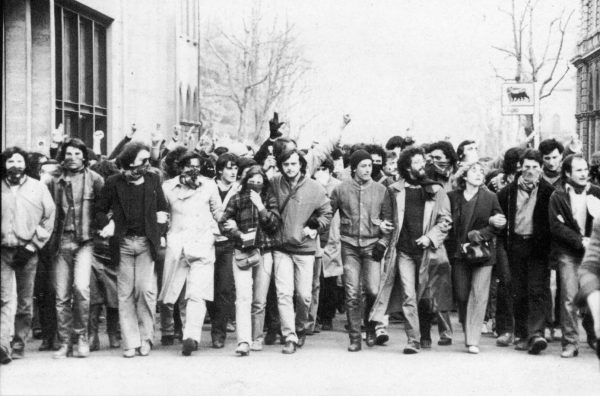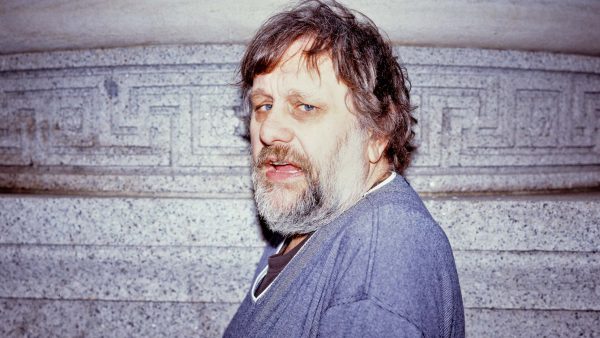I’m not up on the Internet, but I hear that is a democratic possibility. People can connect with each other. I think people are ready for something, but there is no leadership to offer it to them. People are ready to say, ‘Yes, we are part of a world.’— Studs Terkel
Studs was an inspiring historian. The child of Russian immigrants living in Chicago, he spent his life talking to people — famous people from Dr. King to C. P. Ellis and pretty much everyone in between — but mainly to normal people, working people (and, all too often, unemployed people). The classic oral historian, he was an obsessive archivist who told us about economics and politics as felt in our everyday lives. He catalogued the daily routines of communities; the small niggles of wage labour that collected over a lifetime grind us into the floor, as well as the little acts of humanity that we build our relationships on. Studs mapped personal stories of working-class solidarity, and, all told together, he mapped the political changes of almost half a century.
Culture drove Studs. He started his career as a screenwriter and actor, starring in his own sitcom Studs’ Place, until his outspoken political allegiances got him blacklisted by that indignant little senator, Joe McCarthy. In 1952 he got an hour-a-week spot on 98.7 WFMT Chicago, a small local arts station, and soon was broadcasting five days a week. He continued to do so for the next forty-five years. The majority of those broadcasts were interviews and, combined with a number of books of collected memories, they formed his life’s work. In them he talked to the people mass-culture sees only as ‘audience’, and asked them what constituted their own culture of daily life.
Studs died at the dawn of a global financial crisis (his epitaph: ‘Curiosity didn’t kill this cat.’) he might half recognise from his youth; capital, unregulated, crashing like a wall of water through people’s daily experience, tearing apart the fragile homes we’ve made for ourselves. But the way the working class constitutes itself within capital is very different to Studs’ youth, and the culture that emerges from that composition in turn is unrecognisable. Reading the above quote from Studs I was struck by how simply and forcefully he made the case for the changes I see around me, changes engendered by the collision of the most incredible technological development with the political and economic stagnation corruption that defines our everyday life.
I admire the collective intelligence that Studs managed to document. Like Studs, I want to understand how people live everyday, but on the internet; how people create their own culture, how that culture works politically, and how people continue to innovate and change the world in the face of power and financial catastrophe.
One of the most interesting popular political and cultural forms to have emerged out of the shockwave of technological development known as Web 2.0 has been the hashtag. Developed in IRC (Internet Relay Chat) channels, the hashtag came to prominence with the micro-blog and social network Twitter. It’s a kind of metadata tag that, at its most basic, highlights the subject of the tweet and hyperlinks it, aggregating it with other tweets with the same hashtag. In original, pragmatic form it’s short, concise, punchy. The hashtag was a practical solution to the problem of a chaotic surplus of data. It’s safe to say it has become more than that: a multi-purpose radical and poetic form that has emerged as part of a developing culture of workers who are negotiating a new subjectivity straddled between the online (cyberspace) and the offline (meatspace).
The hashtag as metadata tag took on political potency during the ‘Green Revolution’ in Iran, becoming a standard reference for searching for information on key protests and events such as strikes, a pattern that continued throughout the Arab Spring (for example, #Jan25, the original day of action in the Egyptian revolution). As it has morphed into something greater than its original function the hashtag has become, in one form, a bumper sticker for thought. Broadcasting your allegiance, creating pressure through mass use, or highlighting the overlooked moment, the hashtag works as a bold, declarative statement of support (or opposition).
It goes beyond a simple tool of observation, however. As Studs said, ‘People are ready for something’, and many of the political reconfigurations in the West since the beginning of the financial crisis — from SYRIZA to the new far-right — have been attempts at creating a political form that gives flesh to anger and disenchantment with the political and economic system. Disillusioned with parliamentary politics, unrepresented on class terms and materially suffering as cheap credit — the life-blood of neo-liberal economies — dries up, the working class has been trying to reformulate its demands in a political form that reflects everyday lives.
For this reason, the most important, most radical element of the Occupy movement was its hashtags. While the media swarmed around the telegenic sights of occupied city squares worldwide, the significant social effect was happening online. For the first time there was a single place where both anger with the management of the financial system and vague hopes and aspirations for social change could emerge in conversation with each other. #OWS had created a high profile space which encouraged ordinary people to vocalise their problems and solutions, and see themselves as active participants within a potential process of social change rather than observers and practically disenfranchised voters. Whereas the reigning ideology had been that of capitalist realism (‘THERE IS NO ALTERNATIVE’), #OWS fitted a new radical form for a hashtag: that of the town hall or public square, a community-controlled space oriented specifically around the free flow of issues and ideas being thrown up for debate, on a reasonably egalitarian basis (before starting to account for network bias).
The limits of this particular manifestation of the hashtag form are hinted at by Studs Terkel. ‘We are part of the world,’ he wrote — and that world is an interaction between cyberspace and meatspace. Man cannot live online alone. During the early 2000s, many programmers, designers and futurists predicted the internet was increasingly going to function as a ‘second life’, a distinct territory for human experience whereby we would live and work online through avatars divorced of our corporeal state, however much they represented our meatspace personas. Companies, educational institutions and even the military dedicated significant amounts of resources to building self-contained online worlds in which our avatars could operate: second lives. The subsequent boom in social networks proved them massively wrong. Rather than using the net for an autarchic online social experience, instead we increasingly use it as an auxiliary tool to our everyday functioning. The spatial boundaries of the internet are fluid with meatspace; digital natives are comfortable with navigating between the two, using one as an adjunct to give value to the other.
This can be seen as a development of Ray Oldenburg’s ideas on the ‘third place’. Oldenburg stressed the importance of informal venues for public meeting and debate in the development of democratic processes. ‘Third places’ are areas where authority is loosely defined, where there is a primary focus on conversation and not on consumption, where no-one is obliged to attend and there is a playful atmosphere of open discussion. He identified barber shops, cafes and local parks as traditional ‘third places’. But ‘third places’ are sites where a community constructs its own narratives and its own culture. They are places where society reproduces itself in its own image. My first introduction to the concept of the ‘third place’ was through the writer Dougald Hine, who talked about the growth of ‘third places’ since the emergence of social networks. As people use networks to connect with strangers with whom they have a shared cultural or political interest, the need for meatspace locations to realise those relationships in real life increase.
This is a key feature of the radical form for the hashtag. It can potentially help create an online space for open debate and organisation which then realises itself in a real world ‘third space’. That was the radical possibility in the interface between the #OWS hashtag and its meatspace manifestation. To some extent Occupy became a concrete third place for those who coalesced around its representation, an online town square. It was a place for many who opinions and positions that were ‘unheard’ in mainstream culture to finally get voiced. Perhaps some of the democratic failings of Occupy lie not so much in the unwieldy decision-making processes as in their inability to give democratic voice to the hundreds of thousands, if not millions of people who lived in that online public square. The representation of Occupy was its only power, but it failed to include those who utilised that representation (and gave it power) within the democratic process.
***
Much of what people online call political action is actually cultural production. I like it so much more like that. I think it’s important here, then, to briefly talk about the cultural manifestations of the hashtag as a radical form. This cannot be a survey; the hashtag is a polymorphous cultural form loaded like a semiotic buckaroo, disavowing all interpretation. Still, it’s worth exploring some manifestations of the cultural form. For example, the hashtag is making its mark on popular culture through the rise and rise of ‘hashtag rap’, a lyrical flourish pioneered by Big Sean but popularised by Kanye West and possibly mastered by Drake. In ‘hashtag rap’ (called ‘supa dupa flow’ by Big Sean) the end of a line is followed by a pause (symbolising the break for the hash) then a single word or phrase that encapsulates the line. In other words, it’s a lyrical metadata tag. One example is Big Sean’s ‘Supa Dupa Lemonade’:
Bank account got me feelin well #Fargo,
Ballin ’till I get a milla-check #Darko,
I just give em line afta line, afta line afta… Afta line, afta line, #Barcodes
Drake utilises the same form in ‘Over‘ (also, ironically, sampling flows from Dead Prez’s ‘Hip-Hop’):
You too fine to be layin’ down in bed alone,
I could teach you how to speak my language #RosettaStone
In this sense, the hashtag returns to its original, non-discursive function as a metadata tag, a word that encapsulates the content of the tweet. It’s interesting to see this as a lyrical reflection of the linguistic forms pioneered by their core audience, black working-class American youth. Studies have found that, in the US, Twitter is disproportionately used by young black women (a cultural demographic known in the US as ‘Black Twitter’) and hashtags play an important role in the internal dynamics of the community. Not simply functioning as a metadata tag, they also function as discussion topics (frequently appearing as Twitter’s top trending topics). Hashtags also operate as examples of fictive kin relations, especially within working-class youth in the US, usually in the form of #teams. The most common of these is #teamfollowback which works around the mechanism of always ‘following back’ a fellow team member who follows you.
Although tracing a specific lineage is incredibly problematic, the hashtag #YOLO found early favour within this ‘Black Twitter’ demographic. With #YOLO we encounter the hashtag at the beginning of its journey into much more esoteric territory. #YOLO is an acronym for ‘You Only Live Once’ and is fast becoming a lightning online meme. Taken at face value it’s a synoptic hashtag for a display of wreckless teen whimsy: #YOLO is Carpe Diem for the proletariat. But #YOLO also displays a wider trend towards a developing philosophy of a generation of digital natives who are coming of age facing the destruction of the social contract many took as their birthright. Post-internet poet and visual artist Steve Roggenbuck, a creative force behind the developing #YOLO philosophy, summed up the hashtag’s vision:
‘Have you ever done the thing where you sit upside down then the ceiling starts looking like the ground?… We almost had it with dubstep, we almost had it with tumblr and the triangles. Now we got it. #YOLO you sick fuck! All of mortality, all the carpe diem poems of history, all of romanticism is in one hashtag. It’s not a fucking meme, Dad, it’s a lifestyle.’
#YOLO is perhaps the new rallying cry of a generation of post-cyber hippies, an imploration to turn on, log in and drop out of social engagement. Is it the return of a countercultural practice based upon a reactionary negation of politics as represented by the flower children? Perhaps not, perhaps it’s more in line with the revolutionary negation of the politics that emerged in Italian autonomism. Perhaps I’m jumping the gun: a Google search for ‘fuck the police #yolo’ returns 5260 results.
***
These are cultural forms, creative and socially-reproductive acts emerging unregistered or unrecorded from the new, developing subjectivities of both digital natives and the cognitarian labourer. All this operates within a specific environment, the development of a class of cognitarian workers engaged in affective and communicative labour, where the boundaries between work and play melt away. It is this form of the (re)organisation of labour which is structuring our subjectivities, and our cultural production is changing to reflect the world it inhabits.
How does the development of the hashtag form operate within this social and economic reorganisation? How do we reinhabit ourselves as people who are not defined by our labour, when our work is so similar to what previously marked us as human: conversation, creativity, warmth and affection? I would argue through the subversive and the corporeal. Through exploiting the fragile link between cyberspace and meatspace we can help realise subversive social networks in the real world, used for whatever purpose — insurrectionary, organisational, erotic — creates a gap between our labour and our love. Franco ‘Bifo’ Beradi writes ‘the social existence of cognitive workers does not exhaust itself with the [collective] intellect; cognitive workers, in their concrete existence, are bodies whose nerves become tense with constant attention and effort while their eyes are strained in the fixed contemplation of a screen.’ It is the intersection between the corporeal and the virtual where the hashtag form operates as destabiliser, agitator and organiser.
Despite not being up on the internet, Studs got it right, because he had nearly a century’s experience of listening to the everyday stories of working-class people. The internet is a democratic possibility, because it enables people to talk to each other, people who are ready for something, and who can’t get that something from our leaders. But most importantly those who operate online as cognitive workers, as digital natives, are beginning to say, ‘Yes, we are part of the world.’
The hashtag is a poetic, pragmatic and rhetorical starting point that links the virtual and the corporeal. It is the keystone of both a collective intellect and a meatspace community of cognitive workers and unworkers that can create a culture that Studs might recognise: a culture of everyday life lived in opposition to capital. #YOLO.




